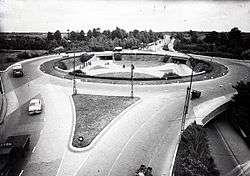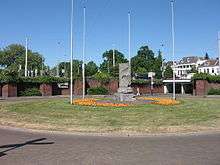Berenkuil (traffic)
A berenkuil (a Dutch word meaning a bear pit[1]) is a type of traffic circle found in the Netherlands. In this construction, automotive traffic is directed around a raised outer circle. This leaves a sunken open space in the center of the circle which is used for bicycle paths.

The Berenkuil in Utrecht
Perhaps the first berenkuil, and the one that gives its name to this type of circle, is the one in Utrecht, built in 1944. There are several theories for the origin of its name, including the possibility that an actual bear pit was located there, or that it was named in honor of the British 49th (West Riding) Infantry Division, nicknamed the polar bears, who liberated Utrecht from the Nazis.[2]
Other examples
- In Eindhoven, the Berenkuil (a traffic circle of the same type on the city's ring road, officially known as Insulindeplein) has become an official free zone for graffiti and has been the site of graffiti festivals.[3][4] In 2011, a new roundabout for cyclists shaped as a kind of “inverted berenkuil”, named Hovenring, has been constructed between Eindhoven and Veldhoven in the Netherlands.[5]

Airborneplein, berenkuil in Arnhem

Lammenschansplein, a berenkuil in Leiden
- Other well-known berenkuil circles in the Netherlands include the Airborneplein in Arnhem, a traffic circle in the access road to the Passewaaij neighborhood in Tiel, a traffic circle in the center of Rijssen on the crossing of the N347 and the N350, and the Lammenschansplein, a traffic circle in Leiden.
- In Brussels, the Verboekhovenplein is commonly called Berenkuil.[6] However, although it has a lowered central area, it is used for a train line rather than for bicycle paths.
- A traffic circle of similar design also exists in southern Tallinn, Estonia, at the intersection of Tehnika and Veerenni.
gollark: Done.
gollark: They lie.
gollark: You can have an osmarks.net subdomain.
gollark: osmarkscloud™?
gollark: It's not metaphorical, it just works with metaphors.
References
- In the old spelling (until 2005) this was spelled berekuil, without the n.
- Bril, Martin (26 April 2007), "Berekuil", Volkskrant (in Dutch).
- "Internationaal graffiti festival in Berenkuil", Groot Eindhoven (in Dutch), 8 September 2010, archived from the original on 19 July 2011, retrieved 5 October 2010
- "Eindhovense Berenkuil krijgt internationaal bezoek", Omroep Brabant (in Dutch), 11 September 2010.
- Render, Nick (11 February 2011), "Hovenring tussen Eindhoven en Veldhoven officieel geopend", Omroep Brabant (in Dutch), retrieved 18 July 2012.
- Berenkuil krijgt brug over spoor, Brussel Nieuws.be, 20 March 2013
This article is issued from Wikipedia. The text is licensed under Creative Commons - Attribution - Sharealike. Additional terms may apply for the media files.